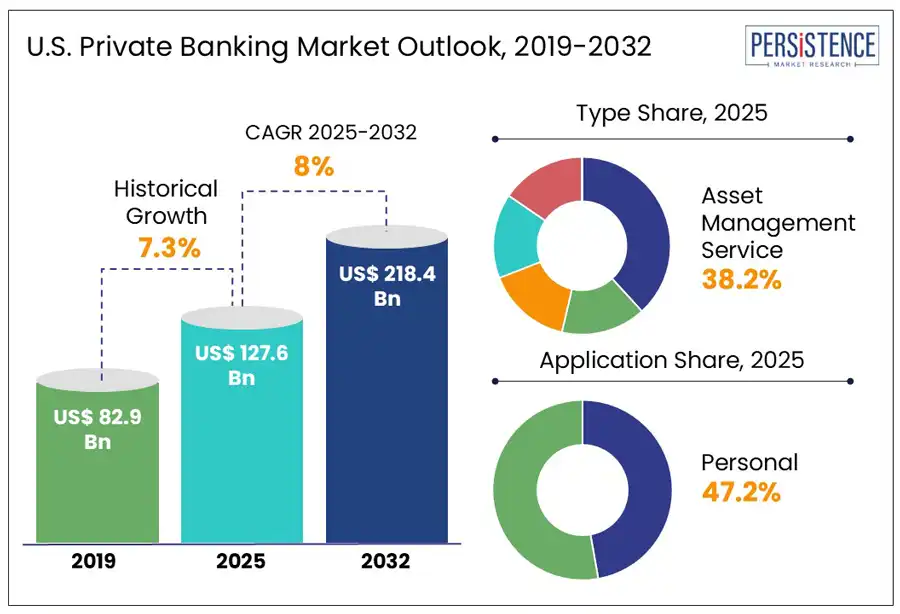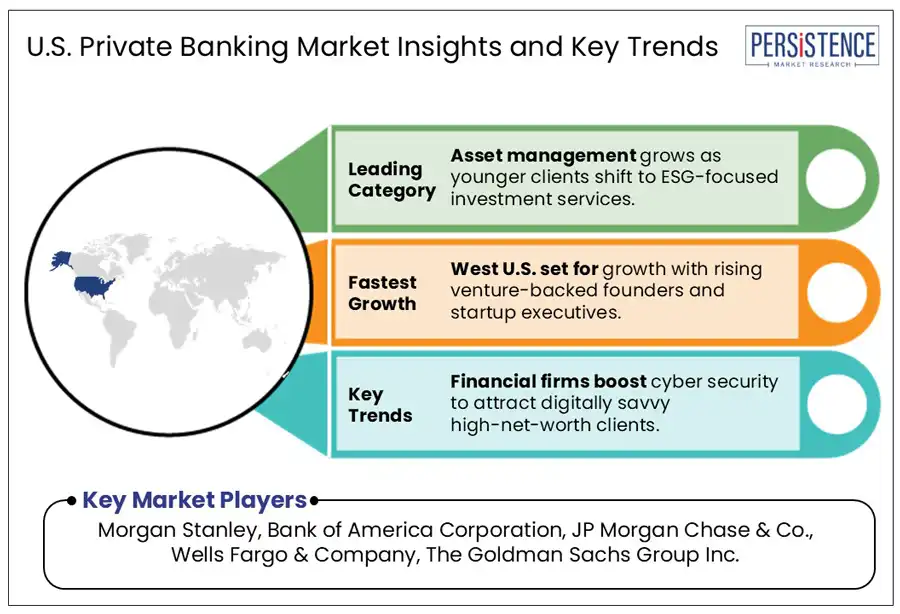Comprehensive Snapshot for U.S. Private Banking Market Research Report, Including Zone and Segment Analysis in Brief.
Industry: Consumer Goods
Published Date: April-2025
Format: PPT*, PDF, EXCEL
Delivery Timelines: Contact Sales
Number of Pages: 180
Report ID: PMRREP35230
The U.S. private banking market size is projected to rise from US$ 127.6 Bn in 2025 to US$ 218.4 Bn to witness a CAGR of 8.0% by 2032. An increase in number of ultra-high-net-worth and high-net-worth individuals (HNWIs) in the U.S. is estimated to spur demand for private banking services. Private banking institutions are significant in shaping earning revenue and investment choices of affluent clients through bespoke wealth-advisory services and asset management fees. Their ability to provide risk management solutions, tax optimization, and personalized financial strategies is predicted to boost demand.

Key Industry Highlights
|
Market Attribute |
Key Insights |
|
U.S. Private Banking Market Size (2025E) |
US$ 127.6 Bn |
|
Market Value Forecast (2032F) |
US$ 218.4 Bn |
|
Projected Growth (CAGR 2025 to 2032) |
8.0% |
|
Historical Market Growth (CAGR 2019 to 2024) |
7.3% |
The U.S. private banking market growth is presumed to be propelled by constant evolution in investment preferences among HNWIs. Conventionally, these wealthy clients focused on portfolios featuring mutual funds, bonds, and equities. Over the past few years, however, there has been a significant shift toward value-based investing, such as Environmental, Social, and Governance (ESG) mandates, customized portfolio strategies, and alternative investments.
The UBS Global Wealth Management stated in a 2023 report that around 76% of HNWIs in the U.S. now seek exposure to alternative assets, including infrastructure, private equity, real estate, venture capital, and hedge funds. This is attributed to a surging requirement for uncorrelated returns and high market volatility. Between 2022 and 2023, even though public markets faced challenges due to rate hikes and inflation, various private market investments delivered stable yields, especially in secondaries and venture debt. Private banks have hence started offering privileged access to direct deals and exclusive fund placements.
Despite the positive growth trajectory, private banking institutions in the U.S. are speculated to face challenges associated with several structural limitations. These are changing how private institutions operate and provide services to clients. One of the most important challenges is the surge in regulatory scrutiny associated with fiduciary responsibilities, anti-money laundering, and tax compliance.
Strict monitoring protocols of the Financial Crimes Enforcement Network (FinCEN) and the implementation of the Bank Secrecy Act (BSA) have made it mandatory for private banks to invest in compliance infrastructure. According to a 2023 survey, around 67% of private banks based in the U.S. reported a hike in compliance costs over the last two years. Several banks have also allocated about 100% of their operating budget to comply with regulatory commitments.
Integration of highly advanced technology is predicted to significantly bolster the adoption of private banking services across the U.S. Wealthy clients are now looking for a smooth blend of personalized advisory and digital convenience, especially next-generation clients and younger HNWIs. Apart from expert guidance, these clients seek intuitive financial tools, real-time insights, and on-demand access.
J.P. Morgan Private Bank, recently launched its Wealth Plan platform. It is a comprehensive digital interface enabling clients to view their financials and run real-time portfolio stress tests based on tax changes or market volatility. At the same time, it allows clients to simulate life events such as major purchases or retirement. The platform utilizes Artificial Intelligence (AI) to help clients make informed decisions by providing personalized suggestions. Similar innovative platforms by other private banking institutions are expected to create new opportunities.
Value-based investing and sustainability are presumed to rapidly reshape the field of private banking in the U.S. It is mainly influenced by changing client expectations, specifically among younger HNWIs. Private banks are upgrading their services to keep up with clients’ values as wealth transfers to more environmentally and socially conscious generations. Their values mainly revolve around governance practices, social justice, and climate change.
Morgan Stanley’s Institute for Sustainable Investing, for example, revealed in 2024 that nearly 85% of Gen Z and millennial investors in the U.S. are showing an increasing interest in sustainable investing. Also, more than 60% of investors have already incorporated ESG factors into their portfolios. It has further supported a reconfiguration in how private banks manage client portfolios. They have started rapidly shifting toward a dual focus approach on non-financial impact and financial returns from conventional performance metrics.
Based on type, the market is segregated into asset management service, real estate consulting, tax consulting, insurance service, and trust service. Among these, asset management services are poised to generate around 38.2% of the U.S. private banking market share in 2025. This is attributed to the increasing demand for customized wealth strategies, backed by complex financial requirements and rising affluence.
Capgemini’s 2024 World Wealth Report, for example, mentioned that in North America, the number of HNWIs surged by 7.1% in 2023, with total wealth increasing by 7.2%. This rapid growth is further pushing private banks in the U.S. to provide more value-added and personalized services, mainly asset management, to extend and retain client relationships.
Tax consulting, on the other hand is estimated to showcase considerable growth in the foreseeable future. Rising wealth concentration among HNWIs in the country is envisioned to spur the segment. Private banking clients often require special strategies to manage their liabilities across international taxation, estate, capital gains, and income. This is anticipated to make tax consulting a key value-added service.
In terms of application, the market is bifurcated into personal and enterprise. The personal segment is predicted to generate a share of nearly 47.2% in 2025, finds Persistence Market Research. This is due to the increasing complexity of individual financial goals. HNWIs now seek a holistic suite of services that includes legacy management, tax optimization, philanthropic giving, and retirement planning.
Goldman Sachs and J.P. Morgan reported that the interest of wealthy clients in bespoke family office services and donor-advised funds has significantly surged. Ongoing expansion of similar services is speculated to turn private banks into strategic partners for lifestyle and life-stage management, and not just custodians of wealth.
Enterprise will likely exhibit a decent CAGR through 2032, on the back of rising demand for integrated financial solutions from corporate executives and business owners. The U.S. Small Business Administration revealed that around 99.9% of all U.S. enterprises are small businesses, and a sizable percentage of HNWIs obtain their wealth from closely held companies. This overlap between personal wealth and enterprise ownership is poised to require private banking services to help address business transition strategies, succession planning, and corporate liquidity events.

Growth in the West U.S. is mainly spurred by the maturation of affluent demographics in states such as Colorado, Washington, and California. The zone, specifically Los Angeles, Seattle, and the San Francisco Bay Area, houses various ultra-high-net-worth individuals (UHNWIs), generated from successful start-up acquisitions, venture capital exits, and technology IPOs. In 2024, California had more than 20% of the HNWI population in the U.S., propelled by wealth generated in the renewable energy sector, Hollywood, and Silicon Valley.
Private banks in the West focus on customizing their services according to the varying client requirements. City National Bank and First Republic, for example, have been targeting entertainment industry professionals, venture capitalists, and start-up founders. They are offering concierge-style services, impact investing options, and personalized lending to attract more clients.
Southeast U.S. is currently undergoing significant transformations with an influx of HNWIs from West Coast and the Northeast. States such as Tennessee, Florida, North Carolina, and Georgia are projected to become important hubs for private banks to extend their presence. This is attributed to business-friendly climates, relatively low cost of living, and favorable tax structures.
As per a recent migration study, Florida witnessed a net gain of more than 90,000 high-income households compared to other states in 2023. Many of these households brought significant assets along with them. Hence, increasing migration is likely to spur demand for private banking services, including discretionary portfolio management, tax advisory, and estate planning.
The Midwest’s wealth is deeply rooted in industrial legacies and family-owned businesses, unlike tech-heavy costs. A new study found that the Midwest consists of nearly 18% of the total HNWI population in the U.S. The population concentration is high in Missouri, Ohio, Minnesota, and Illinois. Chicago, being a key hub for private banking services in the zone is home to various leading players such as Wintrust Wealth Management, BMO Private Bank, and Northern Trust. As of Q1 2024, Northern Trust, for example, reported more than US$ 1.5 Tn in assets under custody for private clients. Its majority of the share originate from renowned foundations and legacy families in the Midwest.
The market for private banking in the U.S. is moderately fragmented, and it houses several companies offering a wide range of investment services. A few companies are focusing on mergers and acquisitions to address specific challenges related to guidelines. Some of the other companies embrace collaboration and partnership strategies to co-develop new services or technologies related to banking.
|
Report Attribute |
Details |
|
Historical Data/Actuals |
2019 - 2024 |
|
Forecast Period |
2025 - 2032 |
|
Market Analysis Units |
Value: US$ Bn/Mn, Volume: As Applicable |
|
Geographical Coverage |
|
|
Segmental Coverage |
|
|
Competitive Analysis |
|
|
Report Highlights |
|
|
Customization and Pricing |
Available upon request |
By Type
By Application
By Zone
To know more about delivery timeline for this report Contact Sales

The market is projected to be valued at US$ 127.6 Bn in 2025.
Increasing number of HNWIs in the U.S. and surging focus on ESG mandates are key drivers.
The U.S. private banking market is poised to witness a CAGR of 8.0% from 2025 to 2032.
The integration of AI into financial platforms and the desire for personalized wealth strategies are the key market opportunities.
Morgan Stanley, Bank of America Corporation, and JPMorgan Chase & Co. are a few key players.